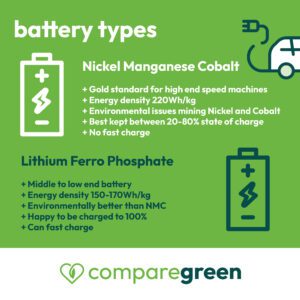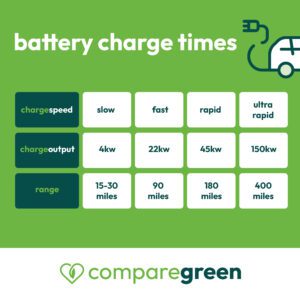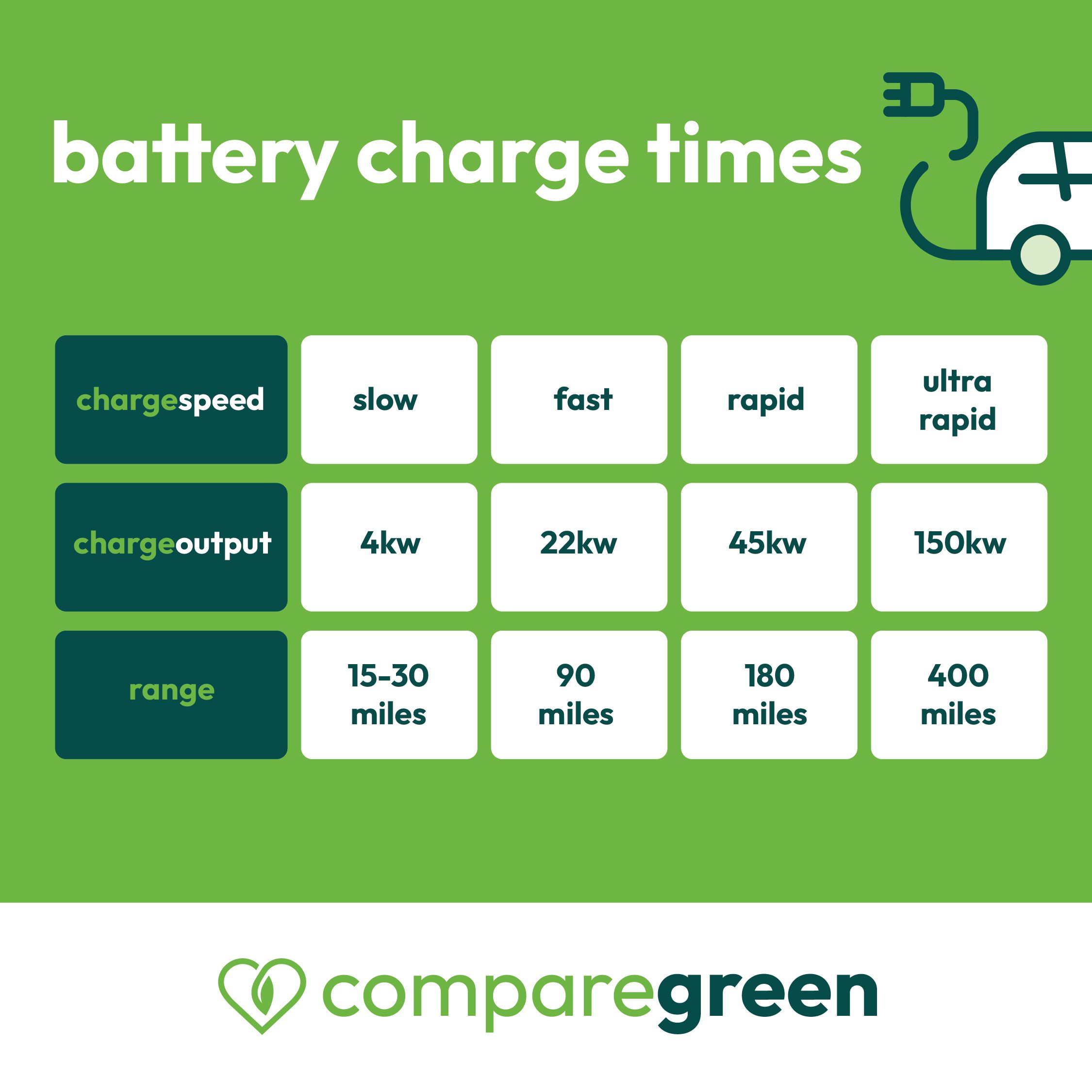EV cells and batteries
What do I need to know about EV battery type, lifespan and charge time? Now for some chemistry basics!
- A cell is where the electrochemical reaction takes place releasing power
- A module is a pack of cells
- A battery is a pack of cells or modules
There are three active parts of a battery:
- The anode that stores positive ions,
- The cathode that stores negative ions
- The electrolyte that they travel between.
When a battery is turned on the lithium ions flow between the anode and cathode, creating a current.

When you introduce a current to the battery from the outside, the lithium flows from the cathode to the anode. This is how charging works. The higher the current the quicker this will happen, though too high and a chemical reaction can take place causing a fire. This is why not all cars can take a very rapid charge.
Anodes are almost always graphite. Battery chemists are spending their time looking for the perfect cathode.
The two main cowboys in town
Nickel Manganese Cobalt (NMC) and lithium ferro-phosphate (LFP) have won the race to be the best chemistries to use in EVs today. What are these?

Nickel Manganese Cobalt (NMC)
NMC is the gold standard electric car battery cathode chemistry of today. NMC batteries have typical energy densities of 220Wh/kg.
Nickel is one of the best storage materials for lithium. The problem is nickel is a reactive metal so manganese and cobalt are combined to make it less prone to fire.
These batteries can be charged and discharged more quickly. If you want an EV that does 0-60 in three seconds, an NMC battery is ideal. There are drawbacks.
Cobalt is found in greatest concentrations in countries like the Democratic Republic of Congo, where its mining has caused great environmental destruction and harm to human health. These have made manufacturers queasy about using it. It is also why chemists are trying to reduce cobalt use in EV batteries. They have been successful to some extent, getting it down to as little as 10% of the cathodes without knock on safety issues.
Nickel is becoming very expensive due to global demand for it in cathodes. This, and the cobalt issue, is why you will generally find NMC batteries in premium end cars.
Lithium Ferro Phosphate (LFP)
Lithium iron phosphate cathode batteries are increasingly going into middle and lower end cars thanks to the battery density. Currently, EV makers are getting 170Wh/kg – less than the 220 Wh/kg in NMC batteries.
LFP batteries have more stable chemistry and are less prone to fire than NMC. This means fewer safety systems required to be in the cars. More cells can be fit into less space as a result.
Battery charge/discharge: LFP batteries won’t release the sort of energy to let a car hit 60 in sub-3 seconds. Nor will we see such vehicles capable of taking 350kW of charge on an ultra-rapid charger.
With iron one of the commonest elements on the planet, LFP cells are far cheaper to make. As a result, LFP is very competitive despite its lower energy density and the cars’ slightly reduced performance.
What’s better - LFP or NMC?
Lets face it neither come with an unblemished record
- NMC charges and discharges more quickly – this can mean faster charging and better acceleration
- LFP doesn’t require so many planet-unfriendly metals
- NMC costs more
- LFP is less energy dense
- NMC will be in luxury end cars
- LFP will be in standard range cars
Do used cars have less range?
As of 2023, electric cars of more than five years old won’t have great range and not all will be able to be charged very quickly. When buying a car, ask about the battery health and real world range of the car now. An older Leaf will still do 100 miles, which for most driving is still ample!
Electric car battery lifespan
Most EVs will get 125,000 miles before they fall to 80% of their listed range. Considering most ICE vehicles will get 150,000 miles before becoming uneconomic to run, that’s not terrible.
A number of factors can contribute to shorter battery life:
- How often it has been fast-charged (the fewer the better)
- How many miles it has done in a given year (charge/discharge cycles)
- How often it has been charged to 100%
High mileage drivers may not care too much about long-term battery health so a regular 100% charge may have been done out of necessity. This will be shown in the car’s battery health. Avoid high mileage, lower age cars if possible!
EV battery replacement
Some manufacturers are very careful to only let licensed and certified technicians look at their cars. While that does mean extra cost it does pay to pay someone who knows what they are doing.
If a battery does start to fail there are three things the dealership can do:
- Replace the whole battery
- Replace a module
- Switch off dead cells/modules and switch on redundant cells/modules via battery management system.
The third option is going to be cheaper than the first. Where it comes to a warranty repair, the dealership may try to do the cheaper options too, and it is worth asking them what exactly they are doing so you know for any future failures.
EV battery charge time
No matter what charger is used, your car’s battery management system will limit the amount of charge it will receive. If it won’t take more than 22kW then even if you hook it up to a 150kW charger, it will still take 22kW. This is down to safety – too much power put into a battery will cause a battery fire.

You should keep your battery between 20% and 80% charged most of the time. Electric car drivers like that 20% safety net as a cushion thanks to the problem of broken chargers too.
Most electric car drivers will want to slow charge their cars at home. It is far cheaper than a public charger and you can slow charge the battery to 100%.
When it comes to miles per hour charged, there are there are four categories:
- Slow charging is 3.5kW to7.5kW, and will add up to 15 or 30 miles per hour respectively
- Fast charging is 22kW, and can give up to 90 miles per hour plugged in
- Rapid is 43-50kW and will give up to 90 miles in half an hour
- Ultra-rapid chargers are 150kW and up, and will give typically 200 miles in 30 minutes.
The faster the charge you want, the more you will pay per kWh. While on a home slow charge you will pay less than 28p/kWh, on an ultra-rapid charger this could be 90p/kWh in future. For those who like the lower costs of driving an EV that can be prohibitive.
What about the negatives of EV batteries?
Its true theres a few downsides to EVs particularly in the mining of minerals needed for manufacture. Find our how green EVs are.



